A Comprehensive Analysis of Foundational Insights and Transformative Applications
Figure 1: Central Dogma and Transcription’s Pivotal Role

1. Foundation of Molecular Biology
A. Gene Expression Architecture
-
Information Flow:
-
Transcription converts static DNA into dynamic RNA messages
-
Enables rapid cellular adaptation (minutes vs. hours for DNA replication)
-
-
Quantitative Control:
-
RNAP II kinetics (initiation, pausing, elongation) tune protein output
-
Single-cell studies reveal transcriptional bursting dynamics
-
B. Evolutionary Conservation
-
RNAP Homology:
Organism RNAP Subunits Sequence Identity Humans vs. Yeast RPB1 75% Humans vs. Bacteria β subunit 50% -
Universal Machinery:
-
TATA-box binding proteins conserved from archaea to mammals
-
2. Gene Regulation Mechanisms
A. Epigenetic Control

Histone modifications act as “molecular switches” for transcription
B. Non-Coding RNA Networks
-
Regulatory RNAs:
-
miRNA: Post-transcriptional silencing
-
lncRNA: Chromatin remodeling (e.g., Xist-mediated X-chromosome inactivation)
-
Enhancer RNAs: Facilitate promoter-enhancer looping
-
3. Disease Pathogenesis Insights
A. Cancer Transcriptomics
-
Oncogenic Drivers:
-
MYC overexpression hijacks transcriptional machinery
-
Mutant p53 loses tumor suppressor functions
-
-
Diagnostic Biomarkers:
-
Fusion transcripts (e.g., BCR-ABL1 in leukemia)
-
Alternative splicing signatures
-
B. Neurodegeneration Mechanisms
-
Repeat Expansion Disorders:
-
C9orf72 GGGGCC repeats cause RNAP II stalling in ALS/FTD
-
Toxic dipeptides from RAN translation
-
4. Biotechnology Revolution
A. Therapeutic Innovations
| Technology | Application | Mechanism |
|---|---|---|
| mRNA Vaccines | COVID-19 immunization | Synthetic mRNA encoding antigens |
| CRISPR Activation | Gene therapy | Targeted promoter enhancement |
| PROTACs | Cancer treatment | Degradation of oncogenic TFs |
B. Synthetic Biology
-
Engineered Circuits:
-
Inducible promoters for metabolic engineering
-
RNAP-based biosensors detecting pathogens
-
5. Evolutionary Biology Insights
A. Transcriptional Innovation
-
Gene Family Expansion:
-
Zinc-finger TFs drive morphological complexity
-
-
Regulatory Divergence:
-
85% human-chimpanzee differences in enhancer regions
-
B. Origin of Eukaryotes
-
Archaeal-Viral Fusion:
-
Eukaryotic RNAP II shares homology with viral enzymes
-
TBP originated in archaea
-
6. Future Research Frontiers
A. Single-Cell Multi-Omics
-
Spatio-Temporal Mapping:
-
Resolve transcription dynamics in 4D (x,y,z + time)
-
-
Clinical Integration:
-
Single-nucleus RNA-seq for precision oncology
-
B. AI-Driven Prediction
-
Deep Learning Models:
-
Predict promoter strength from DNA sequence
-
Design synthetic regulatory elements
-
Conclusion
RNA transcription research provides four transformative contributions to biology:
-
Fundamental Understanding: Elucidates information flow from DNA to phenotype
-
Disease Decoding: Reveals mechanisms of cancer, neurodegeneration, and genetic disorders
-
Biotechnological Innovation: Enables mRNA vaccines, gene therapies, and synthetic biology
-
Evolutionary Insights: Traces conservation of molecular machinery across 3.5 billion years
Emerging technologies—from single-cell transcriptomics to AI-driven design—will unlock real-time transcriptional monitoring and programmable gene circuits, revolutionizing medicine, agriculture, and bioengineering.
Data sourced from public references. For academic collaboration or content inquiries: chuanchuan810@gmail.com
